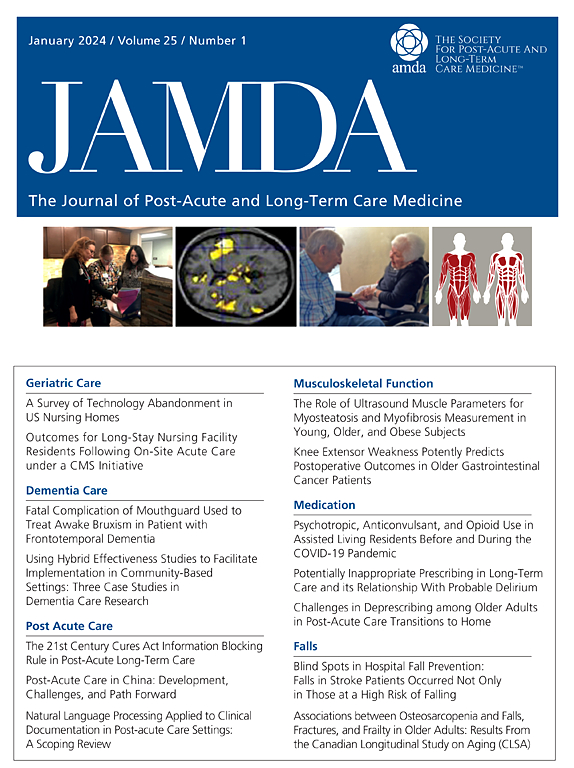Black-White Differences in Long-Term Services and Supports (LTSS) Deserts: Implications for Unmet Care Needs
IF 4.2
2区 医学
Q2 GERIATRICS & GERONTOLOGY
Journal of the American Medical Directors Association
Pub Date : 2025-07-22
DOI:10.1016/j.jamda.2025.105758
引用次数: 0
Abstract
Objectives
Little is known about the impacts of living in a long-term services and supports (LTSS) “desert,” where there are few community-based care options. We sought to understand whether racial disparities exist in LTSS availability and variety and associations with unmet care needs for non-Hispanic White and Black older adults.
Design
Cross-sectional study of national survey data linked to contextual LTSS market measures.
Setting and Participants
Non-Hispanic White (n = 1751) and Black (n = 603) adults aged 70 and older with activity limitations from the 2019 National Health and Aging Trends Study (NHATS).
Methods
The outcome of interest is any adverse consequence as the result of unmet care needs for household, self-care, or mobility activities. We estimate multivariable logistic regression models adjusting for a novel measure reflecting LTSS availability and variety (fertile, typical, desert), consisting of the number of home health agencies, residential care/assisted living beds, and adult day care providers in a county per 100,000 older adults.
Results
Relative to White older adults, Black older adults more often experienced adverse consequences due to unmet need (35.0% vs 27.6%, P < .03). Although not statistically significant, older Black adults were more likely to live in an LTSS desert (P < .058). In fully adjusted within-group multivariable logistic regression models, living in an LTSS desert was associated with greater odds of experiencing adverse consequences due to unmet need among White, but not Black, older adults (adjusted odds ratio, 1.50; 95% CI, 0.95–2.36). For both White and Black older adults, single older adults and those receiving unpaid or paid community-based care were more likely to experience adverse consequences due to unmet need.
Conclusions and Implications
Findings underscore differences in how LTSS availability and variety relate to unmet care needs for Black and White older adults. Future research should examine these associations in other racial and ethnic minoritized groups.
长期服务和支持(LTSS)荒漠的黑人-白人差异:对未满足的护理需求的影响。
目的:人们对长期服务和支持(LTSS)生活的影响知之甚少。“沙漠”,那里几乎没有社区护理选择。我们试图了解种族差异是否存在于LTSS的可用性和多样性,以及与非西班牙裔白人和黑人老年人未满足的护理需求之间的关系。设计:与LTSS市场措施相关的国家调查数据的横断面研究。背景和参与者:来自2019年国家健康和老龄化趋势研究(NHATS)的70岁及以上活动受限的非西班牙裔白人(n = 1751)和黑人(n = 603)。方法:关注的结果是由于未满足家庭、自我护理或活动活动的护理需求而导致的任何不良后果。我们估计了多变量logistic回归模型,该模型调整了反映LTSS可用性和多样性(肥沃,典型,沙漠)的新措施,包括家庭健康机构,住宅护理/辅助生活床和成人日托提供者在一个县每10万名老年人中的数量。结果:相对于白人老年人,黑人老年人更容易因未满足需求而发生不良后果(35.0% vs 27.6%, P < .03)。虽然没有统计学意义,但老年黑人成年人更有可能生活在LTSS沙漠中(P < 0.058)。在完全调整的组内多变量logistic回归模型中,生活在LTSS沙漠中的白人老年人因未满足需求而经历不良后果的几率更高,而黑人老年人则没有(调整优势比,1.50;95% ci, 0.95-2.36)。对于白人和黑人老年人来说,单身老年人和接受无偿或有偿社区护理的老年人更有可能因需求未得到满足而经历不良后果。结论和意义:研究结果强调了LTSS的可用性和多样性与黑人和白人老年人未满足的护理需求之间的差异。未来的研究应该在其他种族和少数民族群体中检查这些关联。
本文章由计算机程序翻译,如有差异,请以英文原文为准。
求助全文
约1分钟内获得全文
求助全文
来源期刊
CiteScore
11.10
自引率
6.60%
发文量
472
审稿时长
44 days
期刊介绍:
JAMDA, the official journal of AMDA - The Society for Post-Acute and Long-Term Care Medicine, is a leading peer-reviewed publication that offers practical information and research geared towards healthcare professionals in the post-acute and long-term care fields. It is also a valuable resource for policy-makers, organizational leaders, educators, and advocates.
The journal provides essential information for various healthcare professionals such as medical directors, attending physicians, nurses, consultant pharmacists, geriatric psychiatrists, nurse practitioners, physician assistants, physical and occupational therapists, social workers, and others involved in providing, overseeing, and promoting quality

 求助内容:
求助内容: 应助结果提醒方式:
应助结果提醒方式:


